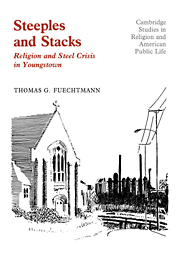Book contents
- Frontmatter
- Contents
- List of Tables and Figures
- Acknowledgments
- Introduction
- I Steeltown
- II The Industry
- III Shutdown
- IV Coping with Crisis: Community Response to the Shutdown
- V Religion and Urban Economic Crisis
- VI Launching a Movement
- VII The Plan
- VIII Negotiations
- IX Ending, Learning, Beginning Anew
- X Epilogue
- Notes
- References
- Index
Introduction
Published online by Cambridge University Press: 29 March 2010
- Frontmatter
- Contents
- List of Tables and Figures
- Acknowledgments
- Introduction
- I Steeltown
- II The Industry
- III Shutdown
- IV Coping with Crisis: Community Response to the Shutdown
- V Religion and Urban Economic Crisis
- VI Launching a Movement
- VII The Plan
- VIII Negotiations
- IX Ending, Learning, Beginning Anew
- X Epilogue
- Notes
- References
- Index
Summary
At ten o'clock in the morning on Monday, September 19, 1977, vice-presidents of the Youngstown Sheet and Tube Company appeared for hastily arranged appointments at various offices around Youngstown, Ohio. Reporters were summoned to a news conference at company headquarters, where they were handed a brief press release: “Sheet and Tube” was closing its largest steel mill in its home city. It was expected that five thousand jobs would be terminated, with layoffs beginning the following week.
Context
As an old steeltown, Youngstown knew what it meant for the fires in the furnaces to be blown out. Steel families were nourished on the practical wisdom that smoke and soot from the big smokestacks meant food on the table. Clean skies meant hard times: from strike, recession, depression. Most other times, the furnaces had started up again. One thing could be counted on: the consuming appetite of a young nation for steel to build its bridges and skyscrapers, railroads and ships, cars and appliances. But this time was different. Company officials (since a 1969 merger they were based in New Orleans) were saying that the old mill that was once Youngstown's biggest producer and biggest employer was down for good. Tough third-generation steelworkers walked out the plant gate on their last day with tears in their eyes. In a way, they had known it was coming. Problems for the old mill had been mounting for several years. Production facilities were twenty to forty years behind current steel technology; however, workers could see that normal maintenance was being ignored or deferred.
- Type
- Chapter
- Information
- Steeples and StacksReligion and Steel Crisis in Youngstown, Ohio, pp. 1 - 9Publisher: Cambridge University PressPrint publication year: 1989

